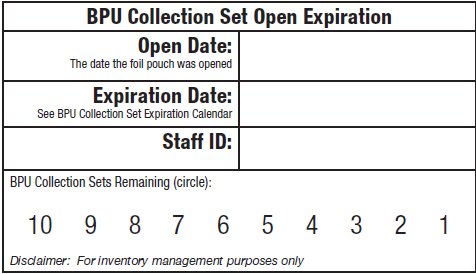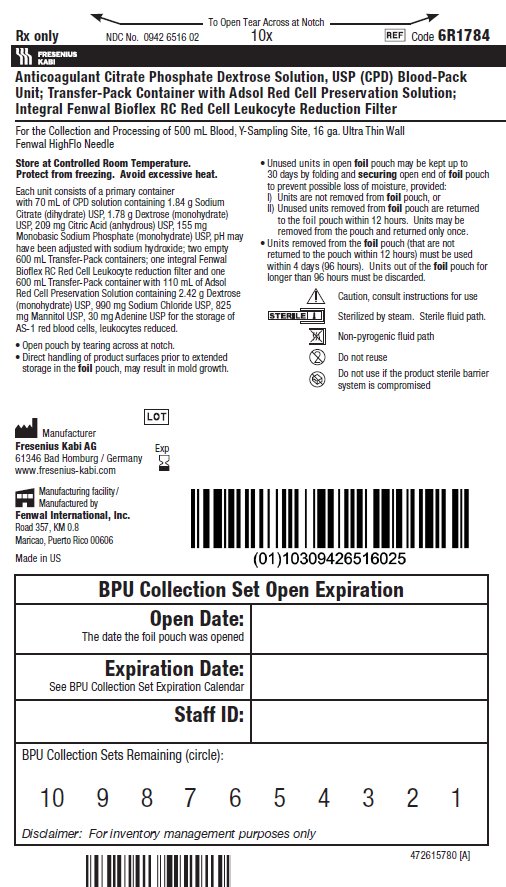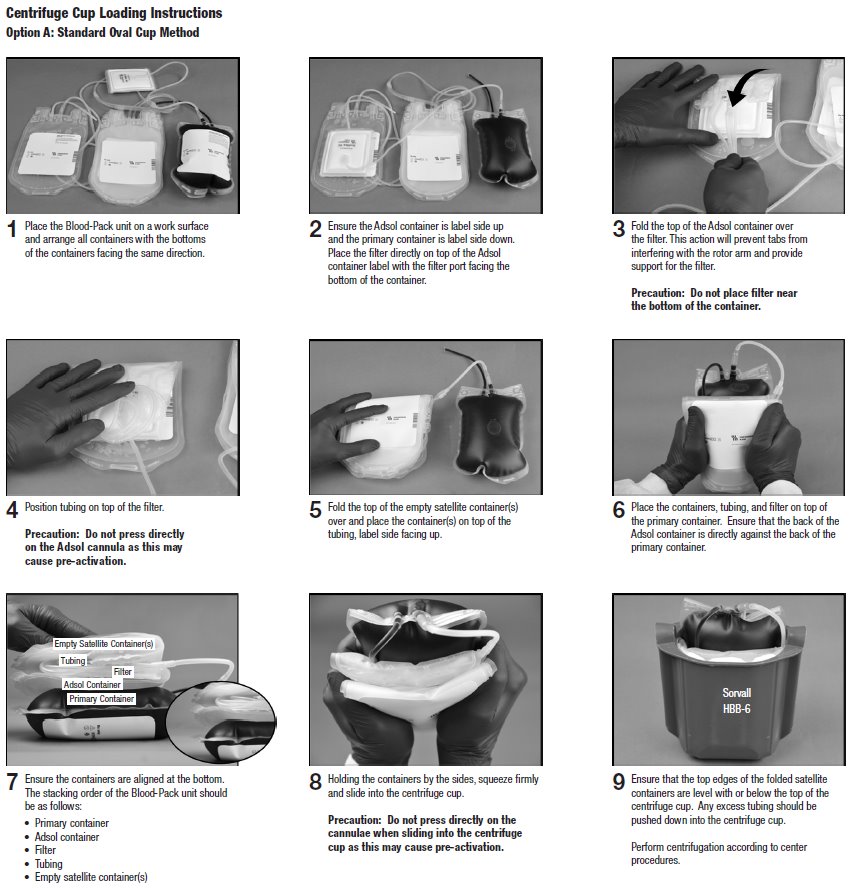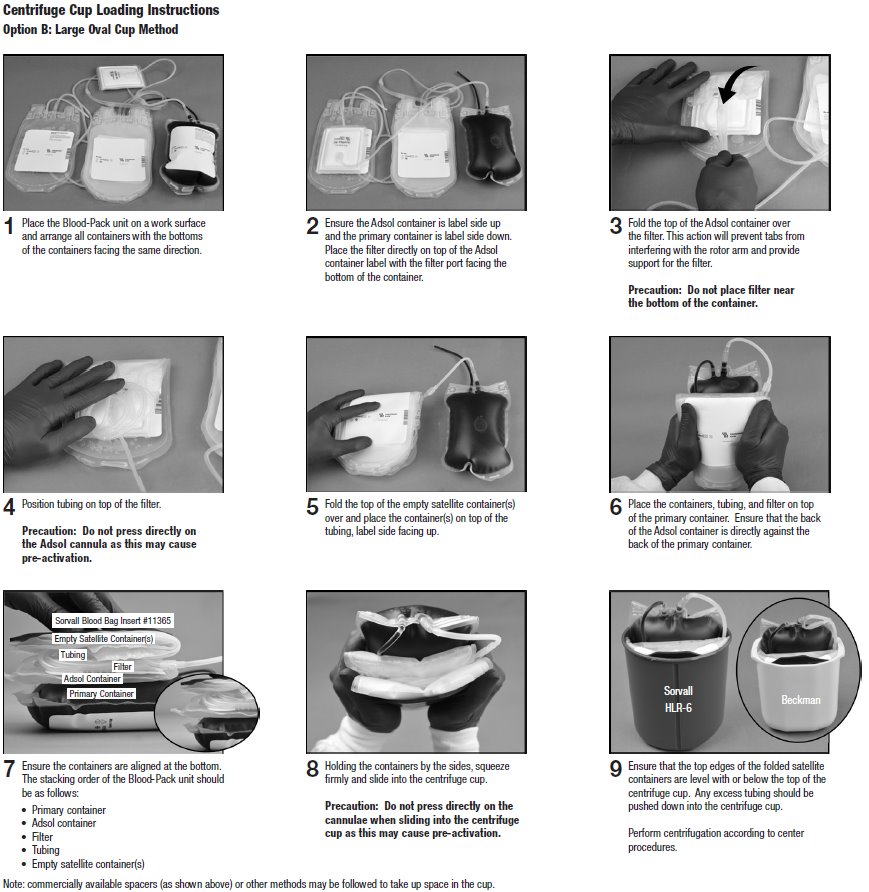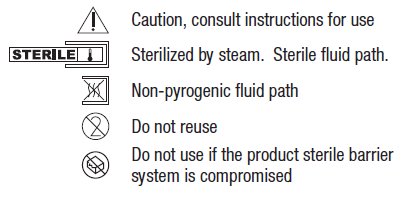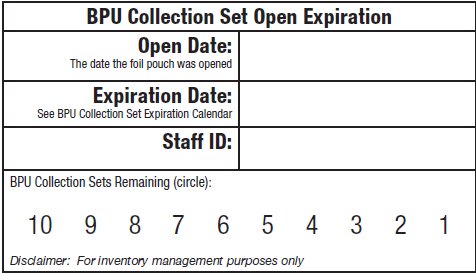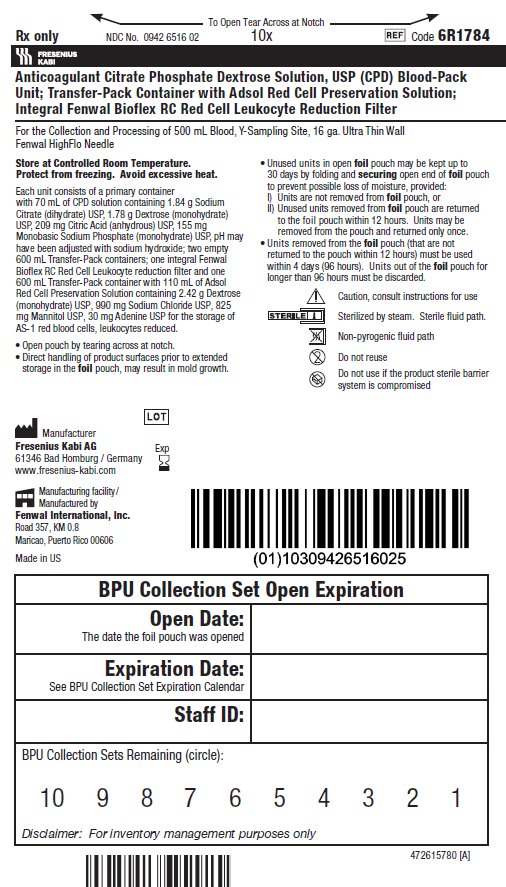Label: ADSOL RED CELL PRESERVATION (anticoagulant citrate phosphate dextrose- cpd and adsol preservation kit
- NDC Code(s): 0942-6516-01, 0942-6516-02, 0942-6516-03
- Packager: Fenwal, Inc.
- Category: HUMAN PRESCRIPTION DRUG LABEL
- DEA Schedule: None
- Marketing Status: New Drug Application
Drug Label Information
Updated November 3, 2022
If you are a consumer or patient please visit this version.
- Download DRUG LABEL INFO: PDF XML
- Official Label (Printer Friendly)
-
Blood-Pack Unit with an Integral Fenwal Bioflex RC Leukocyte Reduction Filter Using CPD/Adsol
Red Cell Preservation Solution for Whole Blood Collection and Filtration of Red Blood Cells and Fenwal HighFlo Needle
Contains Y-Sampling Site for the collection of unanticoagulated whole blood samples for laboratory testing.
Store at Controlled Room Temperature. Protect from freezing. Avoid excessive heat.
Definition of "Controlled Room Temperature":
"A temperature maintained thermostatically that encompasses the usual and customary working environment of 20° to 25° C (68° to 77° F); that results in a mean kinetic temperature calculated to be not more than 25° C; and that allows for excursions between 15° C and 30° C (59° and 86° F) that are experienced in pharmacies, hospitals, and warehouses. Provided the mean kinetic temperature remains in the allowed range, transient spikes up to 40°C are permitted as long as they do not exceed 24 hours ... The mean kinetic temperature is a calculated value that may be used as an isothermal storage temperature that simulates the non isothermal effects of storage temperature variations."
Reference: United States Pharmacopeia, General Notices. United States Pharmacopeial Convention, Inc. 12601 Twinbrook Parkway, Rockville, MO.
Integral filter unit intended for leukocyte reduction of AS-1 red blood cells:
• At ambient temperature up to 8 hours after blood collection.
• At refrigerated temperature (1° to 6° C) up to 3 days after blood collection. If AS-1 red blood cells are prepared within 3 days after whole blood collection.
The leukocyte reduced red blood cells may then be stored for up to 42 days after collection.
Instructions for Use
Collection Procedure:
Use aseptic technique.
Notes:
- •
- If the Y-Sampling Site is not used, donor samples may be collected using an alternative method following standard procedures.
- •
- Nominal tubing dimensions of product are 0.118" inner diameter x 0.025" wall thickness.
Precautions:
- •
- Upon removal of Blood-Pack unit from the clear plastic overwrap, visually inspect the unit.
- •
- Do not use unless the solutions are clear.
- •
- Before beginning procedure, obtain one access device for each Blood-Pack unit with Y-Sampling site to be processed.
1. Identify Blood-Pack unit using appropriate donor identification system.
2. Adjust donor scale to desired collection weight and position primary container on the donor scale as far as possible below donor arm.
3. Clamp donor tubing between Fenwal HighFlo1 needle and primary container. (This step may be performed prior to step 1 or 2.)
4. Following blood center procedures, apply pressure to donor's arm and disinfect site of venipuncture.
5. Remove needle cover per instructions below:
- a) Holding the hub and cover near the tamper-evident seal, twist cover and hub in opposite directions to break seal.
- b) Remove needle cover, being careful not to drag the cover across the needle point.
6. Following blood center procedures, perform venipuncture, appropriately secure donor needle and/or tubing and release clamp on donor tubing. When good blood flow is established, stabilize the front of the needle guard to arm with tape (see Figure 1).
7. Mix blood and anticoagulant in the primary container immediately, at several intervals during collection, and immediately after collection.
8. Collect the appropriate volume based on Blood-Pack unit used.
Note: The volume of anticoagulant is sufficient for the blood collection indicated on Blood-Pack unit ± 10%.
9. Release the pressure on the donor's arm as appropriate.
Precaution: Do not proceed with the remaining steps until the entire whole blood unit is collected.
10. To avoid possible contamination of the whole blood unit, before filling whole blood sample tubes, hermetically seal the donor tubing near the Y-Sampling Site on the side leading to the primary container using a metal clip or appropriate alternate method.
Precaution: Complete steps 11 - 20 within approximately 4 minutes after sealing the donor tubing to avoid possible clot formation in the tubing.
11. To collect samples, insert the access device by pushing firmly into the Y-Sampling Site until the membrane seal is penetrated (see Figure 2).
Note: If the access device is assembled such that the outer barrel is screwed onto the Luer, make sure to rotate clockwise upon insertion to avoid barrel detaching from Luer.
12. Open the cap on the access device (if applicable).
13. Directly align the vacuum sample tube with the internal needle in the access device. Insert vacuum sample tube into device until the stopper is punctured.
14. Allow vacuum sample tube to fill with blood, then remove from the access device.
15. Repeat steps 13 and 14 until the desired number of vacuum sample tubes have been filled.
Notes:
- •
- If the access device needs to be replaced, clamp the tubing between the needle and the Y-Sampling Site. Then, grasp base of Sampling Site with one hand and pull the access device out with the other hand. Firmly insert the new access device. Remove clamp and continue sampling.
- •
- If the access device is assembled such that the outer barrel is screwed onto the Luer, make sure to rotate clockwise upon removal to avoid barrel detaching from Luer.
- •
- The access device can only be replaced one time.
Precaution: When replacing the access device, be careful to avoid contact with any blood droplets on the Luer or Sampling Site. Discard used access device appropriately.
16. Release pressure on donor's arm.
17. If appropriate, apply clamp to donor tubing between needle and Y-Sampling Site.
18. Withdrawal of Needle (see Figure 3).
Precaution: The needle guard must be held stationary while the needle is withdrawn into it.
- a) Place folded sterile gauze over puncture site and hold in place with finger tip without exerting pressure.
- b) Hold sides of needle guard near the front, between the index finger and thumb. Pull the hub back smoothly until the needle is completely enclosed and securely locked into the needle guard.
- c) Confirm the needle is completely enclosed and securely locked into the needle guard.
19. Remove and discard the Y-Sampling Site and needle guard into an appropriate biohazardous waste container following established procedures. If donor tubing is also to be discarded, hermetically seal donor tubing directly above the primary container and remove.
Note: Step 20 may be performed prior to step 19 if desired.
20. If the donor tubing is not hermetically sealed directly above the primary container, then strip the blood from the remaining donor tubing into the primary container and mix. If desired, allow tubing to refill.
Component Preparation:
Notes:
- •
- If a platelet concentrate is to be prepared, it should be separated within 8 hours after blood collection.
- •
- Fresh frozen plasma should be separated from the red blood cells and placed in the freezer at -18° C or colder within 8 hours after blood collection.
- •
- Adsol red cell preservation solution should be added to the red blood cells immediately after the removal of plasma. Preparation of AS-1 red blood cells may vary depending on processing option selected:
- a) Within 8 hours of blood collection if whole blood is held at ambient temperature.
- b) Within 3 days of blood collection if whole blood is refrigerated.
21. At the appropriate time, prepare the Blood-Pack unit with integral filter for centrifugation.
22. Thoroughly mix the primary container end over end.
23. Load the Blood-Pack unit into a centrifuge cup per the instructions on page 3 or 4. Page 3 describes Option A, the method of centrifuge cup loading when using standard oval centrifuge cups. Page 4 describes Option B, the method of centrifuge cup loading when using large oval centrifuge cups. This method differs from Option A in steps 7 - 9 only and shows the use of a blood bag insert to help fill extra space inside the cup.
Notes:
- •
- This guide is one method for centrifuge cup loading and applies to all Bioflex RC configurations. The specific stacking order and methods may vary depending on the workstation setup, centrifuge equipment, and your facilities Standard Operating Procedures.
- •
- It is important to pack the filter properly in the centrifugation cup to avoid damage to the filter during centrifugation.
- •
- Do not place the filter in the lower half of the centrifuge cup. See step 3 on page 3 or 4 for proper placement of filter.
- •
- Do not press directly on the cannulae while performing any of the cup loading steps as this may cause pre-activation of the cannulae.
24. After loading the Blood-Pack unit into the centrifuge cup, perform centrifugation according to center procedures.
25. Following centrifugation, remove containers from the centrifuge cup taking care not to disturb the red blood cell/ plasma interface.
26. Place primary container in a plasma extractor and apply pressure. Clamp off tubing above the filter to prevent plasma flow into filter during plasma transfer. If applicable, clamp off tubing below Y-Junction leading to secondary Transfer Pack container not to be filled with plasma. Open the cannula on the top of the primary container to transfer plasma into the empty Transfer Pack container.
27. When the desired amount of plasma has been removed, clamp the tubing between the plasma container and the Y-connector closest to the plasma container and release pressure on the primary container. Seal and remove satellite container(s).
28. Position the Adsol red cell preservation solution container ensuring that the primary container remains below the level of the filter during prime. Open the cannula on the Adsol solution container and remove the clamp between the primary container and the filter. Transfer the Adsol through the filter into the primary container. Clamp the tubing between the filter and the primary container after prime is complete.
29. Mix the Adsol red cell preservation solution and red cells thoroughly.
Filtration Procedure:
Precaution: Red blood cell products collected from certain donors may have extended filtration times and the potential for ineffective filtration and leukoreduction.
30. Mix unfiltered AS-1 red blood cells thoroughly. Invert the unfiltered AS-1 red blood cells and hang the filter set such that the filter remains vertical. Filtration may be performed from 165 cm up to full length. To achieve maximum flow rate, allow the set to hang to full length. The storage container must remain below the level of the filter during filtration.
31. Filtration must be initiated up to 8 hours after collection at ambient condition or up to 3 days at refrigerated temperature.
32. Inspect all tubing to ensure It hangs freely without kinks.
33. Remove the clamp above the filter to start filtration.
Note: Manual or mechanical pressure should not be used to increase the flow rate through the filter. Tubing below the filter should not be stripped at any time during the filtration process.
Note: If filtration of red cells is initiated at ambient temperature, the filtration process can be completed at either ambient or refrigerated temperature prior to storing the red cells between 1 and 6° C. However, for optimal filtration time, it is recommended to complete the filtration at ambient temperature.
34. When filtration is complete, air can be observed in the inlet side of the filter. Hermetically seal and detach the tubing below the filter.
35. Make segments from the post filter tubing and leave segments attached to the filtered red cell storage container. (QC samples may be prepared by thoroughly mixing the filtered red cells and stripping this tubing prior to sealing the segments.)
36. Store the AS-1 red blood cells, leukocytes reduced between 1 and 6° C.
37. Infuse the red cells within 42 days of collection.
38. Quality control should be per FDA "Guidance for Industry - Pre-Storage Leukocyte Reduction of Whole Blood and Blood Components Intended for Transfusion", current issue.
Warning: Failure to achieve closed system processing conditions negates the extended storage claim and the red blood cell product must be transfused within 24 hours.
1 Van der Meer, P.F., & de Korte, D. “Increase of blood donation speed by optimizing the needle-to-tubing connection: an application of donation software.” Vox Sanguinis 2009, 97:21-25.
©2021 Fresenius Kabi AG. All rights reserved.
All trademarks referred to are property of their respective owners.
Fresenius Kabi AG
61346 Bad Homburg / Germany
www.fresenius-kabi.com
1-800-933-6925
472315539 [A] 2021/09
-
PACKAGE LABEL.PRINCIPAL DISPLAY PANEL
To Open Tear Across at Notch
Rx only
NDC No. 0942 6516 02
10x
Code 6R1784
Fresenius Kabi
Anticoagulant Citrate Phosphate Dextrose Solution, USP (CPD) Blood-Pack Unit; Transfer-Pack Container with Adsol Red Cell Preservation Solution; Integral Fenwal Bioflex RC Red Cell Leukocyte Reduction Filter
For the Collection and Processing of 500 mL Blood, Y-Sampling Set, 16 ga. Ultra Thin Wall Fenwal HighFlo Needle
Store at Controlled Room Temperature.
Protect from freezing. Avoid excessive heat.
Each unit consists of a primary container with 70 mL of CPD solution containing 1.84 g Sodium
Citrate (dihydrate) USP, 1.78 g Dextrose (monohydrate) USP, 209 mg Citric Acid (anhydrous) USP, 155 mg Monobasic Sodium Phosphate (monohydrate) USP, pH may have been adjusted with sodium hydroxide; two empty 600 mL Transfer-Pack containers; one integral Fenwal Bioflex RC Red Cell Leukocyte reduction filter and one 600 mL Transfer-Pack container with 110 mL of Adsol Red Cell Preservation Solution containing 2.42 g Dextrose (monohydrate) USP, 990 mg Sodium Chloride USP, 825 mg Mannitol USP, 30 mg Adenine USP for the storage of AS-1 red blood cells, leukocytes reduced.
- •
- Open pouch by tearing across at notch.
- •
- Direct handling of product surfaces prior to extended storage in the foil pouch, may result in mold growth.
- •
- Unused units in open foil pouch may be kept up to 30 days by folding and securing open end of foil pouch to prevent possible loss of moisture, provided:
- I.
- Units are not removed from foil pouch, or
- II.
- Unused units removed from foil pouch are returned to the foil pouch within 12 hours. Units may be removed from the pouch and returned only once.
- •
- Units removed from the foil pouch (that are not returned to the pouch within 12 hours) must be used within 4 days (96 hours). Units out of the foil pouch for longer than 96 hours must be discarded.
Manufacturer
Fresenius Kabi AG
61346 Bad Homburg / Germany
www.fresenius-kabi.com
Manufacturing facility /
Manufactured by
Fenwal International, Inc.
Road 357, KM 0.8
Maricao, Puerto Rico 00606
Made in US
472615780 REV: A
-
INGREDIENTS AND APPEARANCE
ADSOL RED CELL PRESERVATION
anticoagulant citrate phosphate dextrose (cpd) and adsol preservation kitProduct Information Product Type HUMAN PRESCRIPTION DRUG Item Code (Source) NDC:0942-6516 Packaging # Item Code Package Description Marketing Start Date Marketing End Date 1 NDC:0942-6516-03 2 in 1 CARTON 1 NDC:0942-6516-02 10 in 1 POUCH 1 NDC:0942-6516-01 1 in 1 KIT; Type 1: Convenience Kit of Co-Package Quantity of Parts Part # Package Quantity Total Product Quantity Part 1 1 BAG 70 mL Part 2 1 BAG 110 mL Part 1 of 2 CPD
citrate phosphate dextrose solutionProduct Information Route of Administration INTRAVENOUS Active Ingredient/Active Moiety Ingredient Name Basis of Strength Strength TRISODIUM CITRATE DIHYDRATE (UNII: B22547B95K) (ANHYDROUS CITRIC ACID - UNII:XF417D3PSL) ANHYDROUS CITRIC ACID 1.84 g in 70 mL DEXTROSE MONOHYDRATE (UNII: LX22YL083G) (ANHYDROUS DEXTROSE - UNII:5SL0G7R0OK) DEXTROSE MONOHYDRATE 1.78 g in 70 mL ANHYDROUS CITRIC ACID (UNII: XF417D3PSL) (ANHYDROUS CITRIC ACID - UNII:XF417D3PSL) ANHYDROUS CITRIC ACID 209 mg in 70 mL SODIUM PHOSPHATE, MONOBASIC, MONOHYDRATE (UNII: 593YOG76RN) (PHOSPHATE ION - UNII:NK08V8K8HR) SODIUM PHOSPHATE, MONOBASIC, MONOHYDRATE 155 mg in 70 mL Inactive Ingredients Ingredient Name Strength SODIUM HYDROXIDE (UNII: 55X04QC32I) Packaging # Item Code Package Description Marketing Start Date Marketing End Date 1 70 mL in 1 BAG; Type 1: Convenience Kit of Co-Package Marketing Information Marketing Category Application Number or Monograph Citation Marketing Start Date Marketing End Date NDA BN811104 02/28/2017 Part 2 of 2 ADSOL RED CELL PRESERVATION
adsol red cell preservation solutionProduct Information Route of Administration INTRAVENOUS Active Ingredient/Active Moiety Ingredient Name Basis of Strength Strength DEXTROSE MONOHYDRATE (UNII: LX22YL083G) (ANHYDROUS DEXTROSE - UNII:5SL0G7R0OK) DEXTROSE MONOHYDRATE 2.42 g in 110 mL SODIUM CHLORIDE (UNII: 451W47IQ8X) (SODIUM CATION - UNII:LYR4M0NH37) SODIUM CHLORIDE 990 mg in 110 mL MANNITOL (UNII: 3OWL53L36A) (MANNITOL - UNII:3OWL53L36A) MANNITOL 825 mg in 110 mL ADENINE (UNII: JAC85A2161) (ADENINE - UNII:JAC85A2161) ADENINE 30 mg in 110 mL Packaging # Item Code Package Description Marketing Start Date Marketing End Date 1 110 mL in 1 BAG; Type 1: Convenience Kit of Co-Package Marketing Information Marketing Category Application Number or Monograph Citation Marketing Start Date Marketing End Date NDA BN811104 02/28/2017 Marketing Information Marketing Category Application Number or Monograph Citation Marketing Start Date Marketing End Date NDA BN811104 12/09/2021 Labeler - Fenwal, Inc. (794519020) Establishment Name Address ID/FEI Business Operations Fenwal International, Inc. 091164590 MANUFACTURE(0942-6516) , ANALYSIS(0942-6516) , LABEL(0942-6516) , PACK(0942-6516) , STERILIZE(0942-6516)


